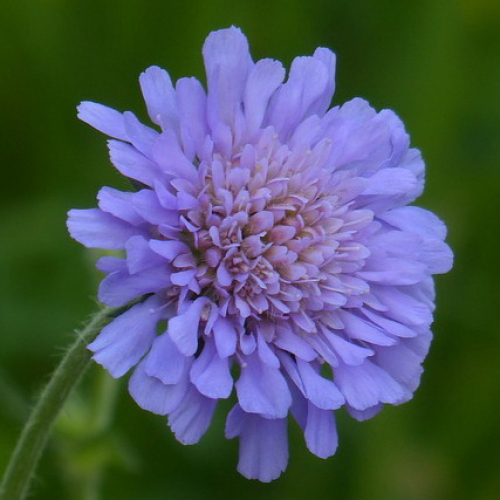Perennials Scabiosa

Description
Characteristic Features of Scabiosa
Scabiosa is a genus of annual and perennial herbaceous plants and dwarf shrubs in the family Dipsacoideae. Although Scabiosa is native to Southern Europe, in the wild, this plant can be found in temperate climates throughout the Old World.
The origin of the name is unclear. One theory is that it derives from the Latin "scabies" (itches) as Scabiosa is believed to treat skin diseases. According to another point of view, the name derives from the Latin "scabiosus" (rough) and refers to rough bracts of the plant.
Scabiosa has an erect stem 20 to 110 centimetres tall. The leaves are pinnate and teethed at the edges. Fragrant flowers are dome-shaped and collected in capitate or globular inflorescences located at the top of the flower stalk and surrounded by bracts. The terminal (ray) flowers are larger, varying in colour from white, blue, pink, scarlet, purple, deep blue, to almost black. Flowers are borne from June to late autumn. The fruit is an achene with small brown oval seeds, remaining viable for three years. One gram contains about 150 seeds.
The genus Scabiosa comprises about 100 species; however, some of them are frequently referred to as a separate genus Knautia, for example, Knautia arvensis (Scabiosa arvensis) or Knautia macedonica (Scabiosa macedonica). These plants have a simple or branched stem that ranges 20 centimetres to 1 metre tall, opposite, feathery, toothed leaves, and capitate or globular inflorescences.
Below is a list of other widely known Scabiosa species:
Caucasian pincushion flower (Scabiosa caucasica) is the most popular species. It is a perennial that grows up to 80 centimetres tall, has branched stems, greyish leaves, and white, blue, pink, or purple capitate inflorescences (depending on variety), with the flowers reaching 8 centimetres across.
Sweet Scabious or Starflower Pincushions (Scabiosa stellata) is an anual that grows to 50 centimetres tall and has light blue flowers blooming in early summer.
Mourning Bride, Egyptian Rose, or Mournful Widow (Scabiosa atropurpurea) is an annual or a biennial, reaching a height of 25-100 centimetres and having toothed leaves and small snow-white, blue, pink, crimson, burgundy, or deep magenta flowers. There are both simple and double varieties.
Yellow Scabious or Cream Pincushions (Scabiosa ochroleuca) is a tall species with pinnate leaves and numerous light yellow racemes.
Scabiosa graminifolia grows to about half a metre tall, with oblong silvery leaves and sky-blue flowers.
Glossy scabious (Scabiosa lucida) is a low-growing plant with pinkish-purple inflorescences.
Pigeon scabious (Scabiosa columbaria) is a very rare biannual or perennial plant that occurs in meadows, among shrubs, or near ponds. Pigeon scabious has an erect stem and red-brown flowers.
In landscaping, Scabiosa is used mainly in ridges, mixed borders, flower beds, and rock gardens, as well as in solitary plantings. The best companion plants for Scabiosa are irises, peonies, monarda, lady's mantle, salvia, hosta, asters, and sage. Tall varieties are used for cutting and have a vase life of over two weeks. Scabiosa stellata is also used to create winter bouquets. In addition, Scabiosas make excellent honey plants.
The Secrets to Successfully Growing Scabiosa
Scabiosa is a low-maintenance, drought- and frost-resistant plant. It is easy to keep and makes a stunning sight with its profuse flowering in the summer.
This plant loves light, so choose sunny locations for planting. The soil should be fertile, lightweight, neutral, and well-drained. The basic care for Scabiosa includes weeding, loosening the soil, feeding with water-soluble compound fertilizer, and regular moderate watering. You need to be especially careful with Caucasian pincushion flower as this species does not tolerate waterlogging, while Pigeon scabious, on the contrary, thrives in moist soils. To prolong blooming, immediately deadhead spent flowers. In general, the plant is very hardy; however, in our climate Caucasian pincushion flower and some hybrid varieties require winter sheltering with a thin layer of dry leaves. In late autumn, cut off the shoots at the root. Every 5 years rejuvenate perennial Scabiosa.
Annual species are propagated by seed. Sow the seeds outdoors in May or indoors in March-April. The best temperature for germination is 15-20 ° C. Prick out seedlings once they have their first set of true leaves. In June, plant the seedlings to a permanent location, spacing 20 centimetres apart. Some species can flower in their first year.
Perennials can be propagated by both seed and division. Divide the shrub in early spring so that each part has 2-3 shoots with roots. Plant in the prepared holes spacing them 30 centimetres apart. Propagation by basal cuttings is also possible.
Potential Problems
Failure to comply with the rules of growing may lead to powdery mildew and fungal diseases. To prevent diseases, avoid waterlogging and overcrowding. At the first sign of the disease, treat the plants with fungicides. Make sure, however, that fungicide does not get on the flowers.







 83 789
83 789







